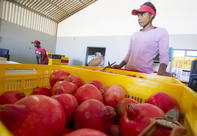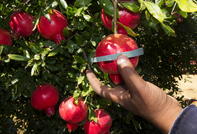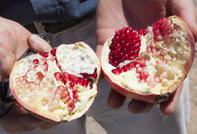Pomegranates can be marketed whole as fresh fruit or processed and sold as arils, juice or as pomegranate seed oil. For exporting, pomegranates are mostly packed as whole fruit in 3,8 kg (Class I and 2) or 15 kg (for processing) cartons.

The fruit is packed in black pulp trays and place inside a StePac bag and then packed into the carton. Local usage includes the sale of whole fruit, arils (popular in salads and Middle Eastern-style dishes), pomegranate seed oil or an antioxidant-rich juice.
Quality gradings are ‘Extra’ (previously Class I), Class I (previously Class II), Class III (mostly sunburnt fruit, suitable for processing for arils) and ‘Class IV’ (juicing quality).
Harvesting of Pomegranates

Due to the tree flowering in three flushes, the fruit ripens in stages and will be picked in three stages. Pomegranates are easy to harvest and if pruning and trellising are done well, the use of ladders will be minimal.
Fruit are clipped with shears as close to the fruit as possible to reduce sharp points of wood that can lead to piercing and skin damage. Fruit are sorted and packed into trays or bins and should be handled with care to reduce bruising. Pomegranate cultivars ripen differently.
For example, Wonderful will ripen internally first. Arils will be sweet, but the skin will still be greenish. The cultivars Acco and Angel Red will ripen externally first. Their skins might be red, but the arils will not yet be sweet.
Test the sugar content before harvesting. Harvest maturity in pomegranates is determined by sugar and the colour of the fruit (both skin and arils). Currently, a maturity indicator of 14º Brix (sugar measurement) is accepted by South African fruit exporter SAPEX. However, recommended sugar levels for cultivars Wonderful and Herskovitz are 16º Brix and for Acco 14º Brix (minimum 13º Brix).
Post-Harvest Handling of Pomegranates
South Africa’s Perishable Products Export Control Board (PPECB) explains that pomegranates are non-climacteric fruits. This means it does not continue to ripen after harvesting. Pomegranates should, therefore, be harvested when they are fully ripe.
Fruit should be washed with a HACCP-quality chlorine or anti-fungal agent, rinsed with water and sorted for quality criteria such as cracks, sunburn insect presence, rot, colour, size and weight. Pomegranates should be put into cold storage as soon as possible after packaging.
The best storage conditions are 6 - 8ºC for export fruit. It can be stored for up to six weeks in normal cold storage and up to five months under controlled atmosphere (CA) conditions according to the PPECB. The optimal CA storage conditions for pomegranates are 3% O2 and 6% CO2 at 5ºC.
Cold damage (chilling injury) causes the pith and the arils to brown and creates brown marks on the skin. Fruit with low sugar content is especially prone to cold damage.
‘Sugar is the pomegranate’s anti-freeze,’ says Jorrie Mulder, technical advisor of the Pomegranate Producers Association of South Africa (POMASA). Pomegranates are very sensitive to moisture loss and, to reduce shrivelling and discolouring, waxing the fruit and using special plastic bags are recommended.
Juicing Pomegranates

Bright red pomegranate juice contains polyphenols (potent antioxidants) that can reduce inflammation in the gut. It has more antioxidants than red wine or green time and a serving of pomegranate juice provides more than 40% of a human’s daily vitamin C needs. To choose a variety for juicing, consider the desirable colour, antioxidant content as well as the best juice yield.
To determine the juice yield as % juice = (juice weight × 100) ÷ whole fruit weight. In South Africa, Wonderful is the best variety for juicing. Pomegranates can be difficult to peel and the juice can stain clothing. When home peeling and juicing, first slice off the calyx and score (cut) the exposed surface into quarters.
Submerge the fruit in a bucket filled with water, pry open the fruit along the score lines and remove the arils with a rolling action under your thumb. The arils will sink to the bottom while the pulp, peel and damaged seeds will float to the top. Home juice production can be simply done by pressing the arils in cheesecloth fabric (or clean dishcloth) or by using an electric blender.
Strain to remove the seeds and cool immediately. Commercial pomegranate juice production may include filtering, purifying and pasteurizing the juice before bottling.
Pomegranate Seed Oil
The dried and cleaned white seeds contain about 18% oil. Pomegranate seed oil is characterised by the presence of high concentrations of punicic acid which has anti-oxidant and anti-inflammatory properties that fight free radicals and slow down skin ageing. Punicic acid is also a natural plant-based estrogen (female sex hormone).
The oil is rich in rare omega-5 essential fatty acid (a very powerful anti-oxidant) which helps repair damaged cells and has shown positive results in studies of women suffering from endometrioses.
Pomegranate seed oil is used in cosmetics and can also be applied to the skin to treat eczema and moisturize dry skin, bring elasticity back to the skin. The oil is cold-extracted from the pomegranate marc (fruit rests that remain after juicing) that contains the seeds and pith.
By Marinda LouwFor bulk or Pomegranates export enquiries please use the enquiry link below.